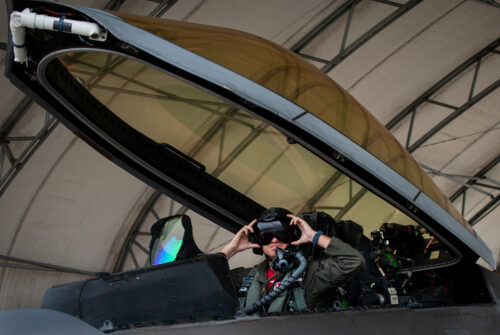The United States Air Force is making strides in improving the equipment and gear for fighter pilots with the testing of a new helmet from LIFT Airborne Technologies. The new helmet aims to provide unparalleled visibility, mobility, and comfort while also reducing the risk of long-term neck and back issues that have been commonly experienced by fighter pilots.

U.S. Air Force photo by Samuel King Jr.
The NGFWH program goal is to provide pilots a more comfortable, stable and balanced platform to accommodate helmet-mounted devices usage without imposing neck strain and discomfort to the user.
Approximately five F-22A Raptor pilots from the 301st Fighter Squadron at Eglin AFB are participating in the testing of the new helmet, which is lighter, cooler, and more readily equipped. The series of tests marks the second round of developmental tests with the LIFT Airborne Technologies-manufactured helmet since it was awarded the contract in 2022. The NGFWH is set to replace the more than 40-year-old current model, known as HGU-55, used by all Air Force aircrew except F-35 flyers.
The new helmet has several advancements that are now standard, including night-vision goggle mounts and an adjustable occipital basket. Previously, these features had to be added manually and adjusted, taking hours to prepare. This new helmet simplifies this process and is easier to adjust if necessary.
After each flight, the pilots report any feedback they have about wearability, visibility, communication, etc. The engineers compile that data to provide to the manufacturers. So far, outside of minor tweaks, the feedback is positive. The pilots are thrilled with the increased visibility and mobility that the helmet provides, making it a significant improvement over the previous model.
The helmet’s improved features are crucial for fighter pilots operating in a high-G within visual range environment. With near-peer threats narrowing the gap daily, it is critical that fighter pilots have every tactical advantage possible. The new helmet’s details matter, including the gear they wear.
The new helmet also has a great effect on aircrew flight equipment technicians. They are responsible for preparing, equipping, and maintaining the helmets for the aircrew. The new helmet’s pre-flight and build-up standpoint are much better and make their job easier in the long run.
When the F-22 squadrons leave Eglin AFB soon for Joint Base Langley-Eustis, Virginia, the test engineers will follow for a new round testing with new pilots. Eventually, the tests will spread out to other aircraft and aircrew, with the next aircraft type scheduled to test the helmets being the HC-130J Combat King II and B-1B Lancer. F-15E flight crews were the first to try out the new helmet.
For more information, hit the Source below